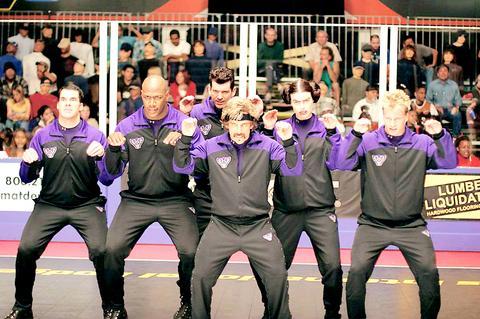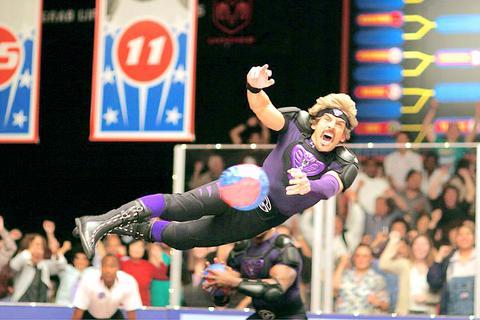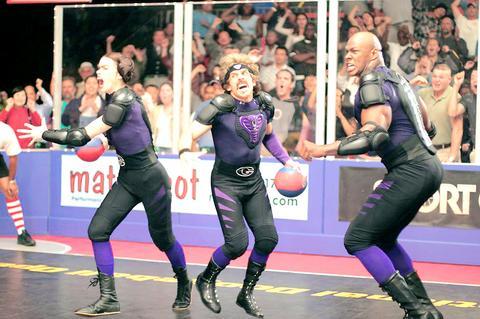In DodgeBall: A True Underdog Story, Ben Stiller returns to the comedy crime scene to portray a monstrous, pumped-up fitness guru and hilarious variation of Derek Zoolander, the airheaded male model he played with pursed-lipped, vacant-eyed perfection three years (and many, many dull movies) ago. Nobody eviscerates the scary depths of male narcissism with such ferocity, and it is a huge relief to find Stiller flexing his oiled, low-comedy triceps with such vengeful glee.
His character, White Goodman, a glaring, preening product of fanatical self-improvement, wears a blow-dry mullet and a Fu Manchu mustache and favors hideous white leisure suits. Affecting the pseudomacho bark of a drill instructor, he suggests Anthony Robbins as a shrimpy, steroid-enhanced gym rat. Making a crude pass at a woman, he remains blissfully unfazed when she throws up in her mouth. "In some cultures, they only eat vomit," he chirps. "I read about it in a book."

PHOTOS COURTESY OF FOX MOVIES
Once a 279kg sack of blubber, White, when alone in his office, practices self-administered aversion therapy in which he attaches electrodes to his nipples and trains himself to resist the temptations of junk food. Before an appointment with a pretty woman, he uses an air pump to inflate his crotch into an outrageous bulge. Stiller, with a face that veers between the geeky and the handsome, and a bunched-up body that even when buffed looks strangely misshapen, skewers male vanity with the X-ray vision of someone who has writhed in its clutches.

White and the world of sneering babes and hunks that crowds his gleaming emporium, the Globo Gym, represent the Goliath that Peter La Fleur (Vince Vaughn), the slobby, nice guy who owns Average Joe's, a nearby low-rent gym, sets out to slay. When a pretty blond bank lawyer threatens to foreclose on Peter's gym unless he comes comes up with US$50,000 in a hurry, White itches to buy the crumbling enterprise and add it to his chain.
The absurd moneymaking scheme that Peter and his nerdy pals come up with is to compete for the US$50,000 first prize in a Las Vegas dodge ball tournament. Never mind that the Average Joes have no experience in the sport. To study it they absorb a grim 1950s instructional film in which a youthful Patches O'Houlihan (Hank Azaria), a legendary dodge ball champion, gives lessons in what he touts as "the sport of violence, exclusion and degradation."

Meanwhile, White assembles his own team, the Purple Cobras, to compete in what one gushing sports announcer describes as an event "bigger than the World Cup, the World Series and World War II combined."

Lo and behold, the aged Patches (Rip Torn) turns up in a motorized wheelchair, his aggression undiminished, to train the Average Joes. His favorite teaching tools, carried in a sack, are wrenches that he hurls full-force at the heads of his pupils to help them master the essential D's of the sport: "dip, duck, dive and dodge." Many head injuries later, the Average Joes have learned their lessons well.
DodgeBall, a promising first feature written and directed by Rawson Marshall Thurber (his previous credits include Reebok commercials) may be a silly throwaway sports spoof, but it is consistently funny. Some of its jokes are tasteless, others envelope-pushing, and some both. The movie loses only a little of its maniacal glee by the time of the playoffs. In the first round, when the Average Joes find themselves facing a team of savagely competitive Girl Scouts, the movie glides up to another peak of daffiness. In a later round, a mix-up in uniforms forces them to prance around the court in skimpy leather and bondage gear.
The movie unapologetically roots for the uber-nerds. And what a curious crew they are. They include a pudgy Panglossian milquetoast (Stephen Root) whose blocked anger explodes in the nick of time; a chicken-chested, absent-minded ninny (Joel David Moore); and a lunatic who imagines he's a pirate. Any movie that is fonder of these losers than of their robotic would-be nemeses is OK by me.

JUNE 30 to JULY 6 After being routed by the Japanese in the bloody battle of Baguashan (八卦山), Hsu Hsiang (徐驤) and a handful of surviving Hakka fighters sped toward Tainan. There, he would meet with Liu Yung-fu (劉永福), leader of the Black Flag Army who had assumed control of the resisting Republic of Formosa after its president and vice-president fled to China. Hsu, who had been fighting non-stop for over two months from Taoyuan to Changhua, was reportedly injured and exhausted. As the story goes, Liu advised that Hsu take shelter in China to recover and regroup, but Hsu steadfastly

Taiwan’s politics is mystifying to many foreign observers. Gosh, that is strange, considering just how logical and straightforward it all is. Let us take a step back and review. Thanks to the Chinese Nationalist Party (KMT) and the Taiwan People’s Party (TPP), starting this year people will once again have Christmas Day off work. In 2002, the Scrooges in the Democratic Progressive Party (DPP) said “bah, humbug” to that. The holiday is not actually Christmas, but rather Constitution Day, celebrating the enactment of the Constitution of the Republic of China (ROC) on December 25, 1947. The DPP and the then pan-blue dominated legislature

Focus Taiwan reported last week that government figures showed unemployment in Taiwan is at historic lows: “The local unemployment rate fell 0.02 percentage points from a month earlier to 3.30 percent in May, the lowest level for the month in 25 years.” Historical lows in joblessness occurred earlier this year as well. The context? Labor shortages. The National Development Council (NDC) expects that Taiwan will be short 400,000 workers by 2030, now just five years away. The depth of the labor crisis is masked by the hundreds of thousands of migrant workers which the economy absolutely depends on, and the

If you’ve lately been feeling that the “Jurassic Park” franchise has jumped an even more ancient creature — the shark — hold off any thoughts of extinction. Judging from the latest entry, there’s still life in this old dino series. Jurassic World Rebirth captures the awe and majesty of the overgrown lizards that’s been lacking for so many of the movies, which became just an endless cat-and-mouse in the dark between scared humans against T-Rexes or raptors. Jurassic World Rebirth lets in the daylight. Credit goes to screenwriter David Koepp, who penned the original Jurassic Park, and director Gareth Edwards, who knows